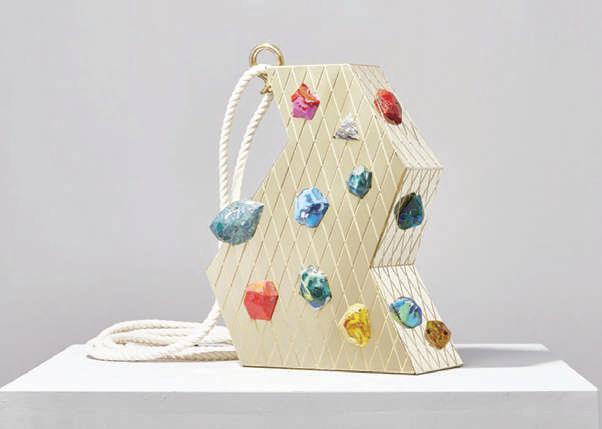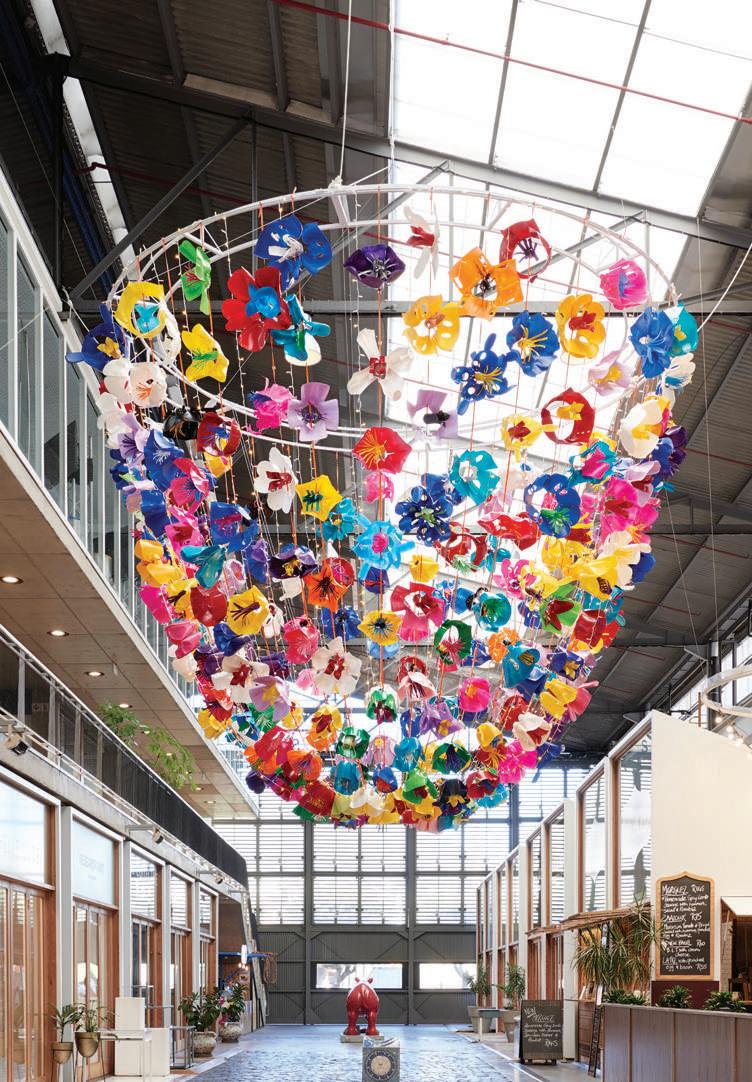
16 minute read
CRAFTING BEAUTY FROM TRASH





From discarded fridges to single-use straws, plastic waste’s creative reinvention is on the rise globally. We share our favourite designers, architects, organisations and artisans who recycle and upcycle as a way to heal the world.















CRAFTING BEAUTY FROM FROM TRASH TRASH
I’D FEEL MORE comfortable writing this piece while sitting on a chair made entirely from materials recycled from a fridge. The chair in question is one of Dutch designer Dirk Vander Kooij’s Chubby chairs, otherwise found in the permanent collections of both the British and Vitra Design Museums. Never having sat on one, I cannot attest to whether it’s more ergonomically comfy than my current seat but, conceptually, I’m confi dent it would put my mind at ease, considering the content of this feature. Made entirely from the plastic materials from a standard discarded fridge – chipped, melted and extruded by a 3D-printing robot – the Chubby chair was designed almost a decade ago, and was incredibly forward thinking for its time. Its origins in the early Twenty-teens precede the darker days of the decade’s conclusion, a time marked by unchecked pollution, a climate in crisis and the subsequent, much‘Designers and corporations intent on needed global awareness of the remaining relevant look to recycling and upcycling as a way to heal the world’ remaining relevant look to recycling and upcycling as a way to heal the world’ dangers of single-use (or virgin) plastics. The Chubby chair’s pioneering use of waste material has inspired a generation’s worth of creativity, an eco-army of design warriors intent on tackling global environmental concerns. Today, the creative reimagining of waste material is commonplace, as designers, both emerging and established, and corporations intent on remaining relevant look to the recycling and upcycling of plastic waste as a way to heal the world. More than a year into a new decade, the Covid-19 pandemic has us rethinking our lifestyles both within and outside our homes. We’re more concerned than ever by the environmental impact Dirk Vander Kooij’s Chubby chairs range, manufactured from Chubby chairs range, manufactured from single-use plastics will have on the natural world, from landfi lls populated by microplastics to that blight in our oceans, the Great Pacifi c Garbage recycled fridge materials recycled fridge materials Patch, estimated to be three times the size of France.
SECOND LIFE
Ever the champion of innovative design, Orlandi’s exhibition is just one component of her Ro GuiltlessPlastic initiative. The Ro Plastic Prize, now entering its third year, is another. Emerging German designer Alexander Schul won the design prize in its inaugural year for his Substantial furniture line. He believes that the most efficient way to recycle plastic trash is by pressing sheet material from it. Schul’s milky-toned tabletop lamp and chair are not only covetable examples of sheet material’s malleability, but also won him the €10 000 prize.
Pressed sheet plastic is also a burgeoning material in interior design and architecture. Rotterdam-based designer Joost Dingemans co-founded Plasticiet, a company that manufactures sheet plastics. With product names like Blizzard and Chocolate Factory, their visual appeal, which references the beauty of natural stone, has been tailored to inspire other creators to build objects that last. It is also a denouncement of thermal recycling, a process of waste incineration that results in carbon emission. Dingemans recently partnered with eyewear brand Ace & Tate on the design of their Antwerp store. He says of the project, ‘There is a major shift going on in retail design at the moment. But many companies are cautious about recycled plastic, first prototyping pop-up or flagship stores to see if it is feasible. I hope that retail brands don’t just use it as a way of convincing customers that they are sustainable while in the background the fashion industry remains one of the most polluting industries.’
Like Plasticiet, The Good Plastic Company is a mission-driven organisation that creates recycled plastic sheets with a low ecological footprint. It has equally adopted the power of suggestion, with a range that includes names like Juicy Lollipop (made from


OPPOSITE TOP The striking interior of eyewear brand Ace & Tate’s Antwerp store, designed by Joost Dingemans of Plasticiet, is made from recycled sheet plastic BOTTOM LEFT Alexander Schul won the Ro Plastic Prize for his Substantial furniture line LEFT Recycled plastic waste was used to create and furnish the lobby of The Student Hotel Delft

single-use cutlery) and Dark Knight (manufactured from household electronic goods), the latter used by British designer Tom Robinson for his flat-pack Evolve chair.
Late in 2020, a custom material made from a combination of recycled refrigerators and cutlery was used by The Good Plastic Comapany in conjunction with two likeminded organisations to create a striking installation in the lobby of The Student Hotel Delft.
The starting point for Danish architect Julien de Smedt’s collaboration with Norwegian start-up Othalo was asking the question: ‘What if we use one of our most pressing problems, the world’s plastic pollution, to solve another, the shortage of quality affordable housing?’ Together they’ve conceptualised a system for building modular houses largely from compacted recycled plastic. ‘Just as cities are formed by buildings of wood, concrete, clay or steel, they could very well contain buildings constructed from plastic waste, as long as it’s done in a safe and sustainable manner,’ says De Smedt of the project, which is called Livo. Focussing on Sub-Saharan Africa as a starting point, the collaborators believe that a 60m2 Livo house could be produced from as much as eight tonnes of reycled plastic; meaning that with the sheer volume of today’s waste, de Smedt calculates that upwards of one billion houses could be built.
Social and environmental reform is not only the concern of independent designers and architects, or small companies and non-profits. Iconic furniture manufacturers Vitra and Magis, both arguably still producing an overabundance of plastic ranges, have each in the past year rereleased a bestseller in recycled polypropylene. Vitra’s relaunch of studio Barber Osgerby’s Tip Ton chair, rebranded as Tip Ton RE, is manufactured from German waste material that is gathered, sorted, shredded, cleaned and processed as granules. Similarly, Magis has rereleased Konstantin Grcic’s monobloc Bell chair using waste from its own factories, really driving home the concept of a circular economy.
THIS PAGE Italian brand Magis launched its Bell Chair, a lightweight, low-cost stackable monobloc chair made from recycled polypropylene
OPPOSITE TOP TO BOTTOM
Studio Swine’s creations are inspired by scrimshaw and made from plastic recovered from an ocean gyre BOTTOM RIGHT Non-profit The Ocean Cleanup is using all proceeds from the sale of its sunglasses range for further clean-ups of the Great Pacific Garbage Patch

SEA CHANGE
An understanding of the escalating threat that discarded virgin plastics pose, particularly to our oceans, has been a slow-burn of the Twenty-teens. In 2015, London-based Studio Swine launched Gyrecraft – fi ve jewel-like objet, inspired by scrimshaw and crafted from plastic collected from a particular ocean’s gyre (a circular current that occurs worldwide on either side of the equator). At the centre of these gyres, plastic mountains amass. ‘Ocean plastic is a totally global problem and it’s a totally global material. It can be treated in a very vernacular way,’ says Alexander Groves, one half of Swine’s design duo.
Across the city, not much more than a year later, advertising creatives Michael Hughes and Dal Evans de Almeida, in collaboration with non-profi t The Plastic Oceans Foundation, submitted a proposal titled ‘The Trash Isles’ to the United Nations. It motivates for the Great Pacifi c Garbage Patch to be recognised by the intergovernmental organisation as an offi cial country. ‘We created everything an offi cial country needs, and worked with designer Mario Kerkstra to design a passport, money, stamps and a fl ag,’ says Hughes of the project’s visually poignant creative.
Another non-profi t organisation, The Ocean Cleanup, has also turned to design to extend the perimeters of its reach. Founded in 2013 by Dutch inventor Boyan Slat, only 18 at the time, the charity last year collaborated with designer Yves Béhar. Together they launched the Ocean Cleanup’s fi rst product, sunglasses, made from


plastics reclaimed in 2019 by the foundation from the Great Pacifi c Garbage Patch. Retailing at €199 per pair, all proceeds from sales are reinvested in further clean-up missions. Slat is confi dent the sale of a single pair allows for the clean up of an area the size of 24 football fi elds. He hopes to stop short at nothing less than 500 000 fi elds.
The iridescence of the sunglasses frames is noticeably different in appearance to Australian designer Brodie Neill’s Ocean Terrazzo. Working closely with engineers, scientists and manufacturers, Neill has pioneered a terrazzo-like composite that brings a jewel-like Neill has pioneered a terrazzo-like composite that brings a jewel-like glamour to recycled ocean plastics. This is most evident in glamour to recycled ocean plastics. This is most evident in his Flotsam table, exhibited as part of esteemed Italian gallerist his Flotsam table, exhibited as part of esteemed Italian gallerist Rossana Orlandi’s Ro Plastic-Master’s Pieces, an exhibition that Rossana Orlandi’s Ro Plastic-Master’s Pieces, an exhibition that brings together global works produced from recycled plastic. brings together global works produced from recycled plastic.



HANDMADE BRIGADE
While international corporations fine-tune their industrial processes to include recycling plastic, many designers focus on the visual rewards that the artisanal and handmade upcycling of discarded plastics can bring. In 2016, Capetonian Heath Nash, an award winner for his creative reworking of domestic waste into desirable homeware, launched Our Workshop. A free-to-use and muchshared NGO space, Our Workshop
is based in Langa, Cape Town, and is a studio where, as Nash puts it, ‘you can turn other people’s trash into money’. Invited by Platform’s creative director Cathy O’Clery to participate in the 2019 and 2020 V&A Waterfront’s festive season installations conceptualised by Platform, Nash and the Our Workshop team created large-scale installations for the Watershed. The more impactful of these was the Colour Extravaganza chandelier, a kaleidoscopic floral hanging comprising upcycled household detergent bottles that had been cleaned and hand-cut.
Equally socially enterprising is Hungarian designer Katalin Huszár’s Notjustuseless project. Dismayed while on holiday at how littered the streets of Portugal’s Bairro Alto neighbourhood were with single-use plastic straws, she went home intent on doing something with what’s likely the worlds most hated plastic item. Huszár launched an experimental eco-design initiative to collect and reuse straws, and in so doing generate awareness of excessive consumer waste. She collected discarded straws at dedicated locations, fused them into a collection of experimental fabrics, and then returned to the same locations to exhibit her work, inviting consumers to see how their not-souseless waste had been transformed.
Handmade fabric from disposed-
of plastic also forms the basis of Egyptian multi-award-winning Reform Studio’s creative offering. Helmed by founders Mariam Hazem and Hend Riad, the studio has invented Plastex, a material comprising cotton or polyester threads interwoven with strands of discarded plastic bags. Plastex is eco-friendly and water-resistant. Seeking not just to upcycle but also to revive the near-lost tradition of Egyptian loom weaving, the duo has empowered communities of men to weave the studio’s fabrics. These are then fashioned into accessories that include clutch bags, fanny packs, totes (one designed in collaboration with IKEA for the retailers Överallt collection) and footwear and homeware ranges.
Empowering communities is a focus for Cape Town-based The Joinery too. Founders Natalie and Kim Ellis believe in ethical design, and ‘outsource’ the handiwork of their luxury office and travel accessories to local sewing co-operatives operating from informal settlements. These seamstresses work with Future Felt, a material woven from nationally sourced, recycled plastic bottles. ‘We do what we do in part to positively contribute to furthering innovation in the textile economy,’ say the sisters of a fabric industry that’s increasingly undergoing sustainability reform.
With such global innovation from companies large and small, and good intention from designers, architects and craftspeople, one would think it would be tough to find critics of the rise of recycled plastics in design. Not so. One such critic argues that recycling is merely another branch of the powerful plastics industry, and that this explains its hold on the media and design worlds.
Belgian educator and curator of the 2018 Istanbul Design Biennial, Jan Boelen, in conversation with Marcus Fairs, editor-in-chief of Dezeen, pronounced the trend as ‘bullshit’. ‘It’s not changing the fundamental problem we have,’ said Boelen, ‘A lot of partners have a big interest in it; it’s business. It’s easy, it relieves our guilt.’ He advocates instead for a systemic change, and encourages designers to look to bioplastics as an alternative. But bioplastics are the subject of another design feature, and I’m yet to find my seat for that.



OPPOSITE The Colour Extravaganza was created by Our Workshop for a series of installations commissioned by Platform for the Watershed at the V&A Waterfront ABOVE Katalin Huszár’s Notjustuseless project turns plastic straws into fabric FAR LEFT AND LEFT Studio Reform weaves Plastex, a material comprising cotton or polyester threads and strands of discarded plastic bags, into furnishings and accessories
Hazendal’s Cape Dutch homestead, which dates back to 1790, has been sensitively restored and now offers elegant winelands accommodation
Step into another era at Hazendal’s The Homestead, an exclusive-use guesthouse for discerning patrons.

GRACIOUS LIVING AT THE HOMESTEAD
IT’S THE SWEET SMELL of thatch that greets you as you step into the airy voorkamer of The Homestead at Hazendal in the Stellenbosch winelands. Let your gaze wander upwards and it will come to rest on original yellowwood beams, while across the room ‘Ndebele Man’ by Vladimir Tretchikoff graces the walls.
It’s one of two pieces by the celebrated artist that are featured here, together with works by Pierneef and a dazzling collection of contemporary African artists. The art is also framed using handselected pieces of period furniture, each carefully chosen to celebrate the rich history of both Hazendal and The Homestead.
It is, in many ways, a step back in time to 1792 – the date on the striking baroque gable – when Hazendal was one of the most prosperous farms in the Bottelary Hills. Today, after a major revamp and rejuvenation, the farm is flourishing once more, and the estate’s new boutique accommodation blends rich history with contemporary five-star luxury.
As an exclusive-use guesthouse, The Homestead offers five opulent en-suite bedrooms, each named for one of the visionary families that have owned the estate since it was founded in 1699. Upstairs an intimate lounge-cum-library offers a quiet space to delve into the history of the farm, while the cosy bar and spacious dining room are perfect for longoverdue family gatherings and celebratory dinners. Your personal butler is always on hand to take care of any and all requests.
It’s the versatility of The Homestead that has made it so soughtafter within months of opening. Bridal parties love it for wedding accommodation, yet it is also in demand by multi-generational travellers looking for a characterful winelands escape with a host of five-star services.
It’s the perfect destination for exploring the scenic Stellenbosch winelands, although, given the diversity of activities and adventures on the estate, you’ll hardly need to leave.
Under executive chef Michélle Theron, Hazendal has become a culinary tour de force in recent years. The Russian Tea Ceremony serves an array of classic Russian delicacies in an elegant space next to the wine cellar. For families, the charming Babushka Deli offers both picnic hampers and al fresco dining, with a dedicated kids’ menu to keep young ones well fed, while the Pivnushka Beer Garden is popular for its delicious flame-grilled fare and craft beers.
Hazendal is also one of the oldest wine estates in the region, and under winemaker Clarise Sciocatti-Langeveldt the estate produces an exciting portfolio of handcrafted terroir-driven wines. Tutored tastings and in-depth cellar tours are an ideal way to discover the vinous heritage of the estate. Then there’s Russian and South African art to discover in the Marvol Gallery, the impressive Classic Car Collection, as well as the wonderful world of Wonderdal, the innovative edutainment centre for kids. There are also indigenous gardens to explore and, mid-2021, a new 18-hole mashie course to have a swing on. It’s a world of winelands discovery in one beautiful estate.
RIGHT (TOP TO BOTTOM) The Homestead at Hazendal offers five opulent bedrooms and presents the ideal accommodation for wedding parties or hosting inter-generational families; the beautifully restored dining area is an ode to heritage and art; simplicity and space characterise the artfully appointed en-suite bedrooms







